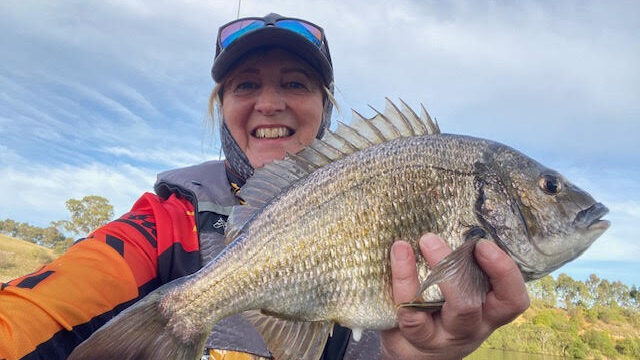For the past six and a half years, I’ve been fully immersed in Bream fishing—spending 90% of my time in my Hobie kayaks and the other 10% in my boat. Three years ago, I moved from South Gippsland to East Gippsland specifically to chase these wonderful sporting fish, and I haven’t been disappointed.
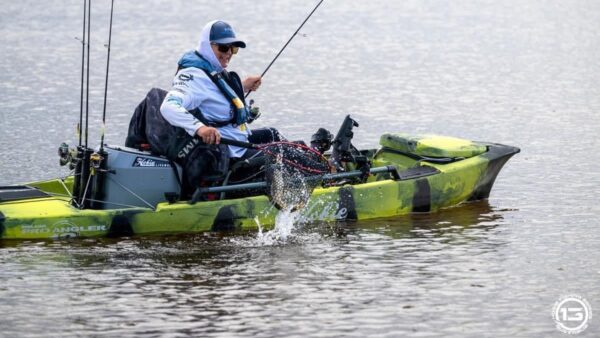
When I first moved here, I was fortunate to fish with several locals who helped me get more hook-ups in all sorts of conditions. Once I started catching bigger fish more regularly, it became hard to think about anything else.
Bream are abundant in the Gippsland Lakes, and I’m lucky to call this area home. No matter the weather, I can head out in my kayak and find a few not far from home. My closest fishing spot is the Mitchell River Backwater, within walking distance. I often head there after work for land-based fishing, primarily for Bream, though I occasionally catch Estuary Perch or even Bass.
My all-time favourite river is the Nicholson River. Its deep edges, rock walls, drop-offs, and structured banks make for some of the best Bream fishing you’ll ever experience. I spend a lot of time here, especially during the cooler months when the fish school upstream and can reach impressive sizes—close to 50 cm. My personal best Bream have been two 47 cm tippers, but the elusive 50 cm fish is still out there. Every time I catch one of these monster-sized fish, I hope it’ll be ‘the one,’ but for now, 47 cm is my best. Still, I’m not disappointed; they can weigh up to 1.5–2 kg, which is a decent size.
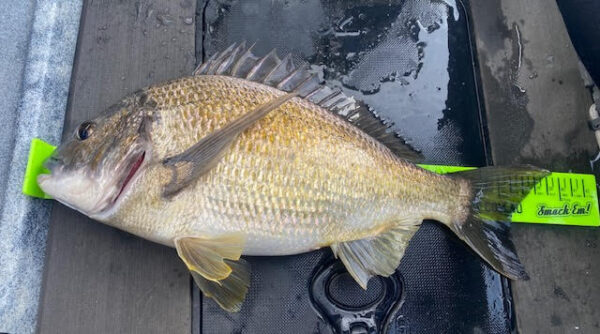
When I first moved to East Gippsland, I fished too lightly. After switching to 1/12 oz jig heads, I started catching a lot more fish. These days, I rarely throw anything but soft plastics, though I’ll switch to hardbodies if it’s a ‘reaction’ bite. Often, Bream will strike my soft plastic as I wind it in without hooking up, but switching to a hardbody minnow or crank profile can help secure a good bite.
The bite can be fast, with a fish on every cast, but other times you really have to work for it. I always check the barometer before heading out. As the saying goes, “1020, fish aplenty,” and it has proven true time and time again. Sudden drops in barometric pressure can often shut the fish down, making it difficult to get a bite. Wild, windy, and wet weather doesn’t make for a great day’s fishing either.
Whenever possible, check the barometer reading (there are apps for this) and see what’s happening the morning or evening before you head out. High pressure often means the fish will be biting, making for a fantastic session on the water. In a competition, low barometric pressure can really play havoc for anglers. If given a choice, go for that 1020 reading any day of the week.
When fishing a new area, I prefer to venture along edges and fish structure. Recently, I’ve been fishing lighter with 1/20 oz jig heads, which has worked wonderfully on the Nicholson, resulting in a high bite rate. I generally throw a variety of plastics to see what the fish fancy.
A minnow profile is usually my starting point, typically in motor oil or bloodworm colour. Lots of tail action on a fairly light jig head should attract a bite. Consider the depth you’re fishing and the surrounding edges, like rock walls, snags, or ledges. Determine the depth closest to the edge by casting a plastic and noting how long it takes to sink or snag. A heavier jig head will snag more quickly than a 1/20 oz. If you’re like me and don’t like losing a lot of gear, try the lighter one first. If it just drifts away from the edge without sinking, go a bit heavier—maybe a 1/16 oz or 1/12 oz jig head—and see how that works.

I like to sit a good distance from the edge in my kayak, casting right in and letting the plastic sink slowly. If conditions are right, you’ll likely get a bite or hook-up. If not, try again and let it sit longer before lifting and giving the plastic some action. Bream often sit and look at the plastic without committing to the bite, and a small hop or lift can be all it takes to entice them.
If you’re getting snagged a lot, losing gear, try using a weedless plastic with a weedless jig head. For added security, glue the plastic onto the jig head ball. I’ve had great success with weedless setups, but I’ve also had just as much or more success with regular jig heads by varying the weight and casting locations.
Timing is crucial. Too much movement can spook the fish, so keep it simple, slow down, and be patient. I like to imagine the jig head and plastic sinking slowly, with the tail fluttering to attract a Bream. Let it sink while keeping in touch with the jig head by taking up the slack in your line and watching the rod tip. A good bite is usually felt quickly, and you’ll see the rod tip bend and the reel let out line. Keep your drag firm but not so tight that the fish pulls the hooks out.
If the fish heads straight for the bank or snags, keep pressure on it, and pop your kayak drive into reverse. This can be risky, but it can also save the fish from busting off in structure. Keeping the fish in open, deeper water is more likely to result in success. Snags are snags, and you’ll lose a lot of gear to them, along with some good fish.
I’ve fished with many people in kayaks, and we often throw the same plastic and weighted jig head, but only I’m catching. Why? Timing those little hops and lifts between taking up the slack in the line makes all the difference. If you’re not getting bites, be patient. Let the plastic stay where it is, maintain contact with the end of the line, and feel for the bite. If the jig head is too light and drifts off too quickly, consider a heavier one.
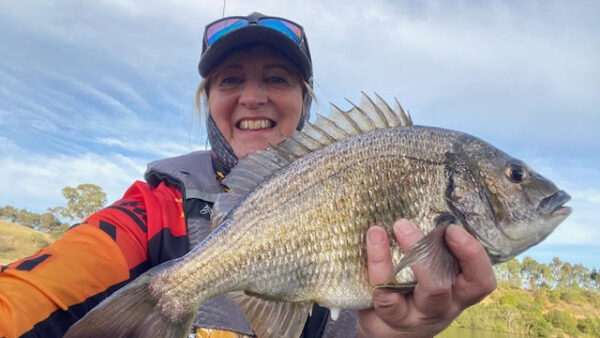
Once, while fishing at Marlo in a VicBream tournament, I could see fish underneath us on the sounder but couldn’t get a bite. My teammate wanted to move, but I insisted on staying to figure out what they wanted. I’d been throwing a 1/12 oz jig head and motor oil plastic, but it wasn’t hitting the bottom, which is crucial when the fish are not biting. I went slightly heavier with a 1/8 oz and got a few touches. Eventually, I tied on a 1/6 oz jig head with the same plastic, and ‘bam,’ the Bream absolutely demolished it. My teammate quickly did the same, and in 30 minutes, we had our bag of five Bream. It was one of the highlights of my tournament fishing career, and my teammate later thanked me for figuring it out.
So, don’t get disheartened if you’re not getting bites. Look around and consider what you’re throwing. Is it the right colour? (What are the fish feeding on? Crabs, prawns, mullet?) Throw something that mimics their bait. Once you’ve figured that out, check the jig head weight. Is it floating away as soon as you cast it, or is it getting snagged? Either way, adapt to the situation. You’ll likely have to change jig heads multiple times during a session, and it’s reasonable to expect to lose several in snaggy areas.
I also enjoy throwing blades and have had great success this year in the Hobie tournaments in NSW, especially on the George’s River in Sydney and at Woy Woy on Brisbane Waters. I’ve fished these venues a few times now and have learned a lot each time. I prefer fishing deep when the edges aren’t producing. Casting out a blade, like a ZX40 in black or matte brown, often gets a bite in deeper areas. Patience is key when fishing deep, but it’s worth the wait when you hook a 40 cm Bream. In a competition, that’s exactly what you’re aiming for, and patience is essential.
Other anglers may come and go without success, but you’ll know if you’re throwing the right lure fairly quickly. Find the fish on the sounder, cast out, and let it hit the bottom—this is crucial. Once the line slackens, slowly take up the excess slack, let it hit the bottom again, and wait. You’ll reap the rewards.
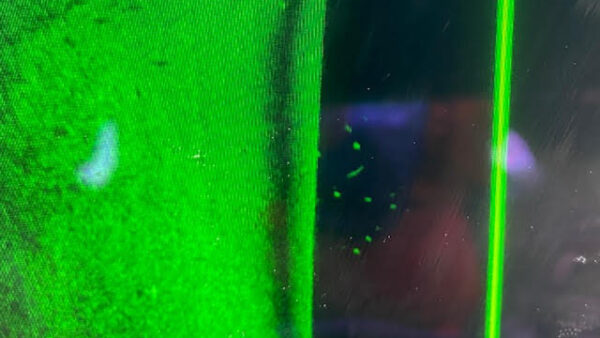
Bream will show up on your sounder like little grains of rice
This year, casting blades at bridge pylons worked well for me on the George’s River. Despite strong currents, I manoeuvred my kayak to get a good cast alongside the pylon, then sat back and waited. Sometimes, the fish hit on the drop, which is great fun. At other times, you really have to work—reverse, forward, and reverse, over and over. Drift too far, head in closer, pedalling all the time. Kayak fishing is no easy feat—I often pedal 15 km during a competition, sometimes more. If I see fish on the sounder, I persevere until I figure out what they want and get the bite.
As I mentioned earlier, I rarely throw hardbodies, except when fishing sandflats. I love throwing cranks and slowly winding them in. Slow is almost always better, whether using plastics or hardbodies. Plastics work too—just use a lighter jig head and wind in slowly with pauses and hops. Bream go crazy for them.
I use scent on plastics and reapply it often. While some debate its effectiveness, I’ve seen days when those who use it catch fish while others don’t. When the bite is tough, anything that gives you an edge is worth it. I carry several brands and apply them all the time. Most of the time, my fingers are covered in it, which is just part of being a serious Bream angler. Of course, on other days, the fish just want to bite, and it’s easy. We all love those days!
For me, Bream fishing is everything. I’ve caught my PBs here in East Gippsland and in tournaments. I fish with a close group of friends, and we all enjoy a day on the water. The camaraderie is unbeatable, and the shared memories of fishing keep us going. We each have our fishing style, which keeps things interesting, but it’s the thrill of the chase that drives us all.
What keeps me hooked? The joy of being out on the water, my kayak gliding over the surface in the early morning light, a cold drink beside me. Then, the thrill of getting a bite, fighting the fish, and the satisfaction of releasing it back into the water. It’s more than a sport; it’s a way of life. And for me, it’s the best life I could imagine.
For more information on Bream, check out the VFAs Rec Fishing Guide.

